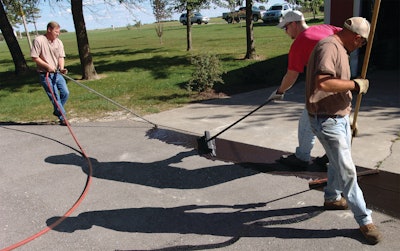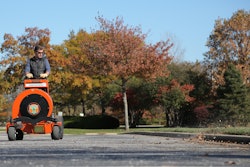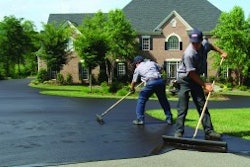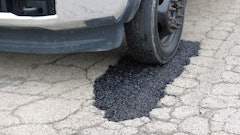
As spring is knocking at the door, the sealcoating season is right around the corner. In the sealcoating business, professionalism and customer care involve making sure protections are in place and equipment is operating at peak performance. This is also a good time to re-evaluate your processes and make sure every member of your crew is on the same page.
The Importance of Equipment Inspections
Most sealcoating equipment sits idle during the off season and it is imperative you give your equipment dedicated time to do a full inspection before use. If you winterized properly, these steps should not be difficult.
Start by walking around the equipment, look for any damage that may have occurred. “Check the tires, make sure they are in good condition and there isn’t dry rotting,” says Eric Humphries, sales manager, Neal Manufacturing, a division of Blastcrete Equipment LLC. “If the tires are low, fill with air to the recommended PSI noted on the tire or in the owner’s manual.”
After the walk around is complete, check the engine, filters and reservoirs. “Give the engine a tune up,” says Cody Hale, national business development for SealMaster. “Replace fuel and air filters, sparkplugs, empty the fuel tank or drain out any water that may have accumulated in the tank before adding fresh fuel.”
It is preferred that you start the season with a clean tank, make sure to check the agitation, pump, gauges, compressors, hoses and spray tips. Brent Loutzenhiser, CEO of Seal-Rite, recommends starting the machine on water. “Put the machine through its paces on water to make sure everything is functioning before putting sealer in.”
If you fail to thoroughly inspect equipment, you could be starting the season off on the wrong foot. Equipment that is not ready for the season could result in failed sealer performance or breakage of the machine, costing time, money and future jobs.
Protect Your Crew
Along with protecting your equipment, you should remind your crews to protect themselves from the elements and the sealer. “Cold tar sealer can cause skin irritation,” says Humphries. “You want to cover every inch of your body that you possibly can.” Proper protection includes Tyvek suits, gloves, safety glasses, tall boots ear protection and sunscreen.
“It’s a good practice to wear sunscreen,” says Loutzenhiser. “Most workers are in the sun on a daily basis, especially apply it to your face.”
Since heat can lead to other issues and potential incidents, and it can't be avoided when a job is on deadline, it is important that all of us working in the heat take care to avoid heat illness issues. Spring can be the perfect time to refresh and train your crews about the symptoms of heat-related illnesses and prevention.
Read More: 18 Tips to Stay Cool on the Jobsite
Sealcoating in the Sunshine
Just as you want to ensure your equipment and crew are ready to work, you also want to make sure the pavement surface is properly prepared for sealcoating and that includes paying attention to the weather.
“You want to try and sealcoat in the sunshine,” says Humphries. “Shade can cause problems and you really don’t want to try to sealcoat on a cloudy day.”
Be sure to check the weather before heading out to a job. If there is rain or high humidity in the forecast, you might want to reconsider applying sealer until there is no rain within a 24-hour period. Sealer shouldn’t be applied in cold or wet conditions because the water in the emulsion won’t evaporate. If water doesn’t evaporate, sealcoat particles can’t begin the curing process of sticking to each other and the coated surface.
Maury Bagwell, lead engineer for Neal Manufacturing, a division of Blastcrete Equipment LLC says “The drying process can take 4-hours or longer. And just because it seems dry, doesn’t mean it is fully cured.”
The curing process takes more time than drying because it takes longer to drive out moisture that remains after the initial drying.
In addition, try to plan applications as early in the day as possible. Avoid applications in late afternoon because it may not have sufficient daylight for proper drying out as well as the danger of temperatures dipping into the freezing zone in late evening.
You’re not only worried about the weather for application, but also making sure the mix doesn’t freeze in the tank. “Remember to watch the weather for dry conditions and appropriate temperatures,” says Hale. “Do not allow your material in the tank to freeze in the early parts of the season.”
As with all surface coatings, the pavement should be clean and free of surface contamination and defects.
- Clean the pavement by sweeping or blowing. Pressure wash high dirt-buildup if necessary and make sure to remove all vegetation from cracks
- Crackfill, patch and in-depth base repair
- Prime oil spots and problematic areas, especially under tree lines
“Preparation of the surface prior to sealcoating is a very important step to successful sealcoating,” says Hale. “Prior to doing any asphalt maintenance, at a minimum the surface should be cleaned with blowers and brooms.”
One Part of a Pavement Maintenance Program
Sealcoating is only one part of a true pavement maintenance program and often times optimizes life-cycle costs of pavement. Cleaning, patching, crack filler, oil spot prep should be completed before the sealcoating process can begin. Also, remember to apply sealcoat according to specifications and manufacturer’s instructions for the number of coats and coverage rates.
Whether contractors are sealcoating driveways or parking lots, the original pavement investment by a customer is significant. Anything you can do to slow the rate of pavement deterioration improves the life cycle costs of that pavement investment. Sealcoating, used as part of a comprehensive pavement maintenance program, plays an important role in extending pavement life.
Once you start your spring season, always follow manufacturer’s recommendations and if you are unsure, ask.












![Lee Boy Facility 2025 17 Use[16]](https://img.forconstructionpros.com/mindful/acbm/workspaces/default/uploads/2025/09/leeboy-facility-2025-17-use16.AbONDzEzbV.jpg?ar=16%3A9&auto=format%2Ccompress&fit=crop&h=135&q=70&w=240)








